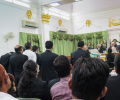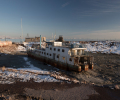Mother Ganga’s hahakaar
The Indian Express – 22nd July, 2012
By Sudheendra Kulkarni
Something akin to an environmental and spiritual genocide is taking place along the course of the Ganga, India’s most sacred river. Yet, very little is being done to stop the crime. Why? One reason is the citizens’ ignorance, apathy and helplessness. A bigger reason is corruption in governments and the political establishment. A still bigger reason is the consumerism-driven model of ‘development’ that India has followed, in which the environment is dispensable and its destruction inevitable.
This is especially evident in ‘Dev Bhoomi’ Uttarakhand, the state where the Ganga originates and where some of the holiest places of Hindu pilgrimage—Gangotri, Yamunotri, Badrinath, Kedarnath, Uttarkashi, Rishikesh, Hardwar—are located. There is a mad rush to build dams of various sizes across the Ganga and its tributaries, to generate power. The number is mind-numbing, some 600 of them. Once these are built, long stretches of the river and its tributaries will simply dry up, an alarming phenomenon that is already visible at many places. This is because the river is being forced to flow through a series of tunnels and artificial reservoirs. This has endangered the flora and fauna in one of the most God-blessed regions in India in terms of beauty and biodiversity. It has also threatened the unique quality of Ganga jal, deemed holy by Hindus all over the world.
If this is Ganga Mata’s plight in Uttarakhand, it gets worse as it flows through UP and Bihar, before merging into the sea at Ganga Sagar in Bengal. At many places, it either disappears or is reduced to a mucky trickle in summer months. Gathering municipal sewage and toxic industrial effluents all along the way, its water becomes unfit for drinking, bathing or any other use. Nearly 300 crore litres of untreated sewage is being discharged into the river daily. This was stated by none other than Prime Minister Dr Manmohan Singh, when he chaired the third meeting of the National Ganga River Basin Authority (NGRBA) in April. No further proof is needed to know that the Ganga Action Plan (GAP), launched by the late Rajiv Gandhi with a lot of fanfare in 1985, was a total failure. NGRBA, too, will fail if it doesn’t correct past mistakes.
Let’s not forget: Ganga is India’s longest river, 2,526 km in length. Directly or indirectly, it affects the lives of nearly 50 crore people living in its basin that covers 11 northern and eastern states. In reality, the Ganga belongs to all of India, like no other river does. In my childhood in Karnataka, a person used to come every year with a pitcher of Ganga jal, which he would devotedly distribute to numerous eager families in my village.
When I visited Kanpur recently, I couldn’t believe how dirty the jal in Ganga has become. In January-February next year, crores of devotees will come to the sangam at Prayag (Allahabad) for the Maha Kumbh. I shudder to think how they can take a holy dip in the unimaginably polluted waters there. True, the pilgrims’ piety often disregards pollution—but for how long? If the Ganga dries up, disappears or gets even more ecologically degraded, will it mean to our future generations what it meant even to someone like Jawaharlal Nehru who wasn’t overtly religious? “The Ganga,” he poetically wrote in his will and testament, “is the river of India, beloved of her people, round which are intertwined her memories, her hopes and her fears, her songs of triumph, her victories and her defeats. She has been a symbol of India’s age-long culture and civilisation, ever changing, ever flowing and yet ever the same Ganga”. Sadly, the Ganga is no longer the same.
The Ganga is ailing. Today it’s a symbol of our sick civilisation.
Bhupen Hazarika, Assam’s legendary artist who passed away last year, sang a popular protest song on the Ganga. It describes the poverty, illiteracy, ill-health and misery of the people living in the river basin. Bemoaning the corruption in politics and the erosion of moral values in society, it asks: Vistar hai apar, praja dono par, kare hahakaar, nisabd sada, Oh Ganga tum, Oh Ganga behti ho kyun? (The people who live along vast stretches on your two banks are screaming in anguish. Yet, O Ganga, why do you flow silently, without a protest? Why?)
If Bhupenda were to sing his song today, I think he’d probably describe Mother Ganga’s own hahakaar, and ask why the people of India have become so silent and uncaring towards her misery.
Environment Minister Jayanthi Natarajan recently said that India needed a “National Commission to Prevent Atrocities against the Ganga”. Brave and welcome words. However, deeds must follow, NOW. Scrap or review all under-construction and proposed dams. Make the rest of India take care of a substantial part of Uttarakhand’s power needs—if necessary, by giving adequate compensation. Implement the national solar mission, which targets generation of 20,000 MW of power, on a war footing. Wage a war on theft of power and also on massive T&D losses. Stop the colossal wastage of irrigation waters, which are diverted from the Ganga. Mandate panchayats, municipalities, and industries—through a policy of empowerment, incentives, disincentives, accountability norms and innovative business models—not to discharge any sewage or effluents into the river. Let’s resolve to make the Ganga, and also all other rivers in India, nirmal (clean) and aviral (free and perennially flowing). We are forewarned: India is doomed if we do not make prudent, responsible, equitable and sustainable use of natural resources our national dharma.
sudheenkulkarni@gmail.com
Click here to read this article in its original location.






